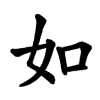Definify.com
Definition 2025
一
一
| ||||||
|---|---|---|---|---|---|---|
Translingual
| Stroke order | |||
|---|---|---|---|

| |||
Alternative forms
Han character
一 (radical 1 一+0, 1 stroke, cangjie input 一 (M), four-corner 10000)
- Kangxi radical #1, ⼀ (“one”).
- Shuōwén Jiězì radical №1
Descendants
References
- KangXi: page 75, character 1
- Dai Kanwa Jiten: character 1
- Dae Jaweon: page 129, character 1
- Hanyu Da Zidian: volume 1, page 1, character 1
- Unihan data for U+4E00
Chinese
|
simp. and trad. |
一 | |
|---|---|---|
| alt. forms |
壹 financial 弌 |
|
Glyph origin
| Historical forms of the character 一
| ||||||||||||||||||||||||||
|---|---|---|---|---|---|---|---|---|---|---|---|---|---|---|---|---|---|---|---|---|---|---|---|---|---|---|
| Oracle bone script | Bronze inscriptions | Bamboo and silk script | Large seal script | Small seal script | ||||||||||||||||||||||
 |
 |
 |
 |
 |
||||||||||||||||||||||
| ||||||||||||||||||||||||||
|
References:
Mostly from Richard Sears' Chinese Etymology site (authorisation),
| ||||||||||||||||||||||||||
| Characters in the same phonetic series (一) (Zhengzhang, 2003) | |
|---|---|
| Old Chinese | |
| 一 | *qliɡ |
| 弌 | *qliɡ |
A horizontal stroke, indicating the number one.
Etymology
From Proto-Sino-Tibetan *ʔit. Descendants from the *ʔit etymon account for the majority of the dialectal forms for ONE in Chinese (Mandarin, Jin, Gan, Hakka, Hui, Xiang, Yue groups, etc.).
In Min, an additional unrelated form is found and used as the colloquial reading for ONE. Compare:
- Fuzhou/Fuding suoʔ8, Fuqing θyo8, Gutian syøʔ8, Ningde søʔ8, Zhouning sɔʔ8, Putian ɬoʔ8, Xiamen/Quanzhou/Yongchun/Zhangzhou tsit̚8, Leizhou/Haikou ziak8, Longyan tse4, Youxiu ɕie7, Jian'ou/Songxi tsi5, Jianyang tsi8, Jian'ou tsi5.
Whether all of the forms above are related and their origins remain unelucidated; they may be derived from 蜀 (cf. 獨 (“single, alone”)), 隻 (< *tjak ~ g-t(j)ik) or 禃.
Some Min Zhong dialects use 個 and 寡 for ONE.
Pronunciation
- Mandarin
- Cantonese (Jyutping): jat1
- Gan (Wiktionary): it6
- Hakka (Sixian, PFS): yit
- Jin (Wiktionary): ieh4
- Min Dong (BUC): siŏh / ék
- Min Nan
- Wu (Wiktionary): iq (T4)
- Xiang (Wiktionary): i6
- Mandarin
- (Standard Chinese, Beijing)+
- Pinyin:
- Zhuyin: ㄧ
- Wade-Giles: i1
- Gwoyeu Romatzyh: i
- IPA (key): /i⁵⁵/
-

- Note: Pronounced 幺 (yāo) when spelling phone number, one on dice or dominoes. Subject to retrograde tone sandhi.
- (Standard Chinese, Beijing)+
- Cantonese
- (Standard Cantonese, Guangzhou)+
- Jyutping: jat1
- Yale: yāt
- Cantonese Pinyin: jat7
- IPA (key): /jɐt̚⁵/
- (Standard Cantonese, Guangzhou)+
- Gan
- Hakka
- (Northern Sixian, incl. Miaoli)
- Pha̍k-fa-sṳ: yit
- Hakka Romanization System: id`
- Hagfa Pinyim: yid5
- IPA: /it̚²/
- (Southern Sixian, incl. Meinong)
- Pha̍k-fa-sṳ: yit
- Hakka Romanization System: (r)id`
- Hagfa Pinyim: yid5
- IPA: /(j)it̚²/
- (Northern Sixian, incl. Miaoli)
- Jin
- Min Dong
- (Fuzhou)
- Bàng-uâ-cê: siŏh / ék
- IPA (key): /suoʔ⁵/, /ɛiʔ²⁴/
- Note: siŏh - colloquial; ék - literary.
- (Fuzhou)
- Min Nan
- (Hokkien)
- Pe̍h-ōe-jī: chi̍t / it
- Tâi-lô: tsi̍t / it
- Phofsit Daibuun: cit, id
- IPA (Xiamen): /t͡ɕit̚⁴/, /it̚³²/
- IPA (Quanzhou): /t͡ɕit̚²⁴/, /it̚⁵/
- IPA (Zhangzhou): /t͡ɕit̚¹²¹/, /it̚³²/
- IPA (Taipei): /t͡ɕit̚⁴/, /it̚³²/
- IPA (Kaohsiung): /t͡ɕit̚⁴/, /it̚³²/
- Note: chi̍t - colloquial; it - literary.
- (Teochew)
- Peng'im: zêg8 / ig4 / êg4
- Pe̍h-ōe-jī-like: tse̍k / ik / ek
- IPA (key): /t͡sek̚⁴/, /ik̚²/, /ek̚²/
- Note: zêg8 - colloquial; ig4, êg4 - literary.
- (Hokkien)
- Wu
- (Shanghainese)
- Wiktionary: iq (T4)
- IPA (key): /i̯ɪʔ⁵⁵/
- (Shanghainese)
- Xiang
| Rime | |
|---|---|
| Character | 一 |
| Reading # | 1/1 |
| Initial (聲) | 影 (34) |
| Final (韻) | 質 (48) |
| Tone (調) | Checked (Ø) |
| Openness (開合) | Open |
| Division (等) | III |
| Fanqie | 於悉切 |
| Reconstructions | |
| Zhengzhang Shangfang |
/ʔiɪt̚/ |
| Pan Wuyun |
/ʔit̚/ |
| Shao Rongfen |
/ʔjet̚/ |
| Edwin Pulleyblank |
/ʔit̚/ |
| Li Rong |
/ʔiĕt̚/ |
| Wang Li |
/ĭĕt̚/ |
| Bernard Karlgren |
/ʔi̯ĕt̚/ |
| Expected Mandarin Reflex |
yi |
| Baxter-Sagart system 1.1 (2014) | |
|---|---|
| Character | 一 |
| Reading # | 1/1 |
| Modern Beijing (Pinyin) |
yī |
| Middle Chinese |
‹ ʔjit › |
| Old Chinese |
/*ʔi[t]/ |
| English | one |
Notes for Old Chinese notations in the Baxter-Sagart system: * Parentheses "()" indicate uncertain presence; | |
| Zhengzhang system (2003) | |
|---|---|
| Character | 一 |
| Reading # | 1/1 |
| No. | 14833 |
| Phonetic component |
一 |
| Rime group |
質 |
| Rime subdivision |
2 |
| Corresponding MC rime |
一 |
| Old Chinese |
/*qliɡ/ |
Definitions
一
- one (numeral, adjective and noun)
- each
- single, alone
- whole, entire, all, throughout
- same, identical
- (literary) another
- With the verb modified reduplicated, expressing the transience of the verb.
- once; as soon as; upon
- (literary) for the first time, at the beginning
- 一見如故 / 一见如故 ― yījiànrúgù ― to hit it off
- (literary) surprisingly, unexpectedly
- 一至於此 / 一至于此 ― yīzhìyúcǐ ― How did things ever get so far?
See also
| Chinese numbers | ||||||||||||||||
|---|---|---|---|---|---|---|---|---|---|---|---|---|---|---|---|---|
| 0 | 1 | 2 | 3 | 4 | 5 | 6 | 7 | 8 | 9 | 10 | 102 | 103 | 104 | 108 | 1012 | |
| Cardinal | 〇 | 一 | 二 | 三 | 四 | 五 | 六 | 七 | 八 | 九 | 十 | 百 | 千 | 萬 万 |
億 亿 |
兆 |
| Financial | 零 | 壹 | 貳 贰 |
參 叁 |
肆 | 伍 | 陸 陆 |
柒 | 捌 | 玖 | 拾 | 佰 | 仟 | 萬 万 |
億 亿 |
兆 |
Compounds
- ⇒ Appendix:Chinese compounds/一
Descendants
Others:
- Lao: ເອັດ ('et)
- Thai: เอ็ด (èt)
Japanese
Kanji
- one
- "one" radical (いち)
Alternative forms
- 壱 (financial or formal)
Readings
- Goon: いち (ichi)
- Kan’on: いつ (itsu)
- Kun: ひと (hito), ひとつ (一つ, hitotsu)
- Nanori: い (i), いっ (it), いる (iru), おさむ (osamu), かつ (katsu), かず (kazu), かづ (kazu), すすむ (susumu), てん (ten), はじめ (hajime), ひ (hi), ひとつ (hitotsu), まこと (makoto)
Compounds
|
|
|
Derived terms
- 一つ (hitotsu): one, 1 (counting)
- 一に (itsu ni): solely, entirely, only, or
- 一は (itsu wa): for one thing, partly
- 一から (ichi kara)
- 一ころ (ichikoro): a trouncing, a beatdown
- くノ一 (kunoichi): female ninja
Etymology 1
From Sinitic 一, from Old Chinese *?yit.
Pronunciation
Noun
Numeral
| < 0 | 1 | 2 > |
|---|---|---|
| Cardinal : 一 | ||
Idioms
- 一からやり直す
- いちからやりなおす
- ichi kara yarinaosu
- start over from scratch
- 一から十まで
- 一か八か
- いちかばちか
- ichi ka bachi ka
- it's a gamble; sink or swim
- 一もにも無く
- いちもにもなく
- ichi mo ni mo naku
- unhesitatingly
Etymology 2
Pronunciation
- On'yomi: Kan'on
- (Tokyo) いつ [íꜜtsù] (Atamadaka - [1])[1][2]
- (Tokyo) いつ [ìtsúꜜ] (Odaka - [2])[1][2]
- IPA(key): [it͡sɯᵝ]
Noun
Etymology 3
From Old Japanese.
/hito2/: [pitə] > [ɸitə] > [ɸito] > [çito]
Pronunciation
Number
- (cardinal) one
Etymology 4
From 始め (hajime, “beginning, first”), stem noun form of verb 始める (hajimeru, “to begin something”). The use of the kanji 一 for the reading hajime is an example of 熟字訓 (jukujikun).
Pronunciation
- IPA(key): [ha̠d͡ʑime̞]
Proper noun
一 (hiragana はじめ, romaji Hajime)
- A male given name
References
- 1 2 3 2006, 大辞林 (Daijirin), Third Edition (in Japanese), Tōkyō: Sanseidō, ISBN 4-385-13905-9
- 1 2 3 1998, NHK日本語発音アクセント辞典 (NHK Japanese Pronunciation Accent Dictionary) (in Japanese), Tōkyō: NHK, ISBN 978-4-14-011112-3
Korean
Hanja
一 • (il)
Eumhun:
- Sound (hangeul): 일 (revised: il, McCune-Reischauer: il, Yale: il)
- Name (hangeul): 하나, 한 (revised: hana, han, McCune-Reischauer: hana, han, Yale: hana, han)
Numeral
一 • (il) (hangeul 일)
- (cardinal) one





















